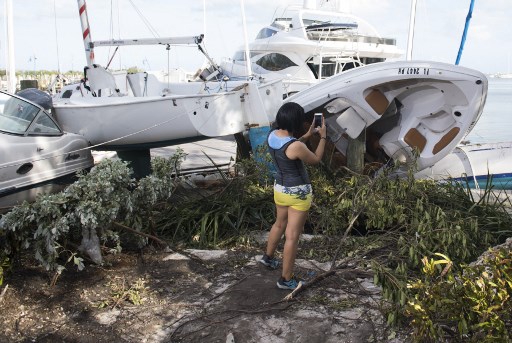
by Leila Macor, with Kerry Sheridan in New Orleans
Agence France-Presse
MIAMI, United States (AFP) — Hurricane Irma was supposed to be a monster storm, immense and record-breaking in size as it charged toward Florida packing a punch that could lay waste to a state that is home to some 20 million people.
But as the sun rose Monday, floodwaters in Florida quickly receded, and torn off roofs, tree-damaged homes and toppled boats were limited to isolated pockets of the state.
Hurricane Irma is blamed for killing at least 40 people across the Caribbean. Just two deaths in Florida were reported by state officials Monday.
“I didn’t see the damage I thought I would see,” Florida Governor Rick Scott said after an aerial tour of the island chain of the Keys, which were hit by the Category Four storm early Saturday.
One of the most alarming warnings had to do with storm surge — a wall of water that rushes over land during a hurricane and often kills far more people than the wind.
In the end, the surge was “not as bad as we thought,” Scott added.
Part of the reason Florida escaped the worst had to do with the path of the storm, meteorologists said.
Hurricane Irma razed the northern coast of Cuba as a potent Category Five storm on its way toward Florida, losing some of its strength in the process.
Its westward shift, away from Miami, also spared the coastal tourist haven from the storm’s fearsome right-front quadrant, with the highest winds and surge potential.
“The storm surge flooding in Miami is a mere fraction of what would have happened if the core of the storm had been further east,” tweeted Rick Knabb, former director of the National Hurricane Center and currently an expert on the Weather Channel.
Orderly exit
With weather forecasters warning of the impact to Florida a full week in advance, many people took time to shutter their windows and take to highways in search of safer ground.
Five and six days out, Irma looked set to charge up the east coast of Florida. In the last day or two, suddenly the Gulf Coast was bracing for the worst.
This uncertainty was unsurprising from a meteorological standpoint, said Irwin Redlener, director of the National Center for Disaster Preparedness and professor at Columbia University Mailman School of Public Health.
“We are way better than we used to be but we are nowhere near where we could be,” he told AFP.
Despite fuel shortages and traffic bottlenecks, Florida somehow managed to evacuate six million people from the vulnerable coasts — a far larger exodus than any other storm in recent memory.
“The evacuation went more smoothly than I thought it was going to go,” Redlener added.
While plenty of Floridians chose to shelter in place, the evacuations likely saved lives and kept first responders out of harm’s way.
Dennis Jones, chief of Hillsborough County Fire Rescue, which includes the city of Tampa, said he was “thankful” for those who left dangerous areas, noting that 260 people had called 911 in the thick of the storm, when emergency crews could not respond.
All those calls were resolved without incident by early Monday, he said.
The worst to come?
But plenty of challenges remain, and the large scale of the disaster zone presents its own problems.
“The real test is going to be in the ability to recover effectively,” said Redlener.
Some 5.6 million customers — or about 15 million people — are without power, and officials warn it could be weeks before the electricity is fully restored.
“We are worried about flooding, housing, debris and power restoration,” Homeland Security Advisor Tom Bossert told a White House press briefing.
“We haven’t assessed yet entirely what the damage is… Remember, it’s a peninsula, it is a wider-scale problem and it has been a larger-swath storm.”
With water lines and sewers damaged in the Keys, debris to clear and power infrastructure to rebuild, Miami Mayor Carlos Gimenez cautioned that the road to normalcy could be rocky.
“We now go through the much longer phase, which is the recovery phase. And believe me, folks, some of this is going to take a while, especially power restoration,” he said.
“But you know what? Inconvenience is a great thing versus having your home destroyed and your life significantly altered.”
© Agence France-Presse








